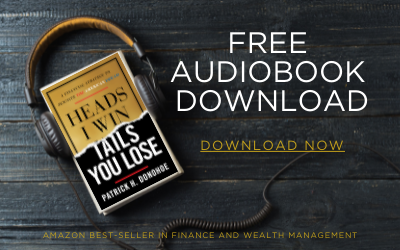De-dollarization is reshaping the global economy as more countries reduce their reliance on the U.S. dollar for trade and financial reserves. Driven by geopolitical shifts, economic diversification, and national sovereignty efforts, this transition affects the dollar’s status as the world’s primary reserve currency—leading to increased use of alternative currencies like the euro and the Chinese yuan.
For individuals, de-dollarization can influence financial stability, investment strategies, and even life insurance policies with significant cash value. At Paradigm Life, we help policyholders navigate economic shifts with The Perpetual Wealth Strategy™, a proven approach that leverages whole life insurance to create financial security, liquidity, and long-term wealth—regardless of global currency changes.
Understanding how de-dollarization affects wealth-building strategies, inflation risks, and policy performance is essential. In this article, we’ll break down the potential impacts on your finances and offer proactive steps to protect and optimize your financial future.
What Is De-Dollarization?
De-dollarization refers to the process by which countries reduce their dependence on the U.S. dollar for trade, reserves, and financial transactions. For decades, the U.S. dollar has served as the world’s dominant reserve currency, providing stability for international markets. However, economic and geopolitical factors are driving a shift toward alternative currencies, such as the euro, yuan, and gold-backed financial systems.
Countries adopting de-dollarization aim to diversify their economies and reduce exposure to U.S. monetary policies, particularly in times of inflation, financial instability, or political tensions. This transition is influencing global trade dynamics, central bank strategies, and individual financial security.
Key Global Trends Driving De-Dollarization
Nations and financial institutions worldwide are actively pursuing de-dollarization due to several emerging trends:
- Geopolitical tensions
- Countries seeking to reduce economic dependence on the U.S. are increasing trade in local currencies.
- Sanctions and trade restrictions have encouraged countries like China and Russia to develop alternative financial systems.
- Economic and monetary policy risks
- The U.S. national debt and inflationary concerns are prompting central banks to diversify their reserves.
- Nations are increasing their holdings in gold, digital assets, and non-dollar reserves as a hedge against U.S. monetary policies.
- The rise of alternative financial systems
- China’s Belt and Road Initiative and Russia’s de-dollarized trade agreements promote the use of non-dollar currencies.
- Digital assets and central bank digital currencies (CBDCs) are emerging as new global transaction mechanisms.
These trends indicate a long-term shift in global financial structures, impacting exchange rates, economic stability, and wealth strategies.
How De-Dollarization Affects Individuals and Businesses
The effects of de-dollarization extend beyond governments and financial institutions—they influence everyday financial decisions for individuals and businesses.
- Currency volatility and purchasing power
- As demand for the U.S. dollar fluctuates, currency exchange rates become more unpredictable.
- Inflationary pressures may weaken the dollar’s purchasing power, affecting savings, investments, and living costs.
- Impact on international investments and trade
- Dollar-denominated assets, such as stocks and bonds, may experience higher volatility.
- Businesses involved in global trade may need to adapt to multi-currency transactions, increasing financial complexity.
- Financial planning challenges
- Higher borrowing costs may arise if reduced demand for U.S. Treasury bonds leads to increased interest rates.
- Businesses may face pricing and cost management difficulties, particularly if they operate in multiple currency markets.
Understanding Life Insurance Policies with Cash Value
Not all life insurance policies are the same, and understanding the differences is crucial for long-term financial success. Life insurance policies with cash value offer more than just a death benefit—they provide a financial asset that grows over time and can be accessed for strategic wealth-building.
Key Types of Life Insurance with Cash Value
- Whole life insurance – the foundation of financial certainty
- Provides guaranteed cash value growth and a fixed death benefit, ensuring long-term stability.
- Cash value earns tax-efficient, predictable growth, making it a cornerstone of The Perpetual Wealth Strategy™.
- Policyholders can borrow against their cash value for investments, emergencies, or major purchases while keeping their money growing.
- Universal life insurance – flexibility with market-linked risk
- Universal life insuranceOffers adjustable premiums and death benefits, but the cash value is linked to interest rates, creating uncertainty in policy performance.
- Higher risk of underfunding if interest rates decline or if policyholders do not contribute enough to cover rising costs.
- Variable life insurance – market-driven volatility
- Cash value is invested in sub-accounts, similar to mutual funds, meaning returns depend on market fluctuations.
- No guarantees on cash value growth, making it a less reliable option for long-term financial planning.
While whole and universal life insurance both offer cash value, whole life insurance provides the greatest level of security, liquidity, and control, aligning with proven wealth-building strategies.
How Cash Value in Life Insurance Grows Over Time
The cash value in life insurance serves as a stable, tax-efficient asset that grows in three key ways:
- Premium contributions a portion of each premium builds the cash value.
- Guaranteed growth – whole life insurance offers contractual growth that compounds over time.
- Dividends (where applicable) – policies from mutual insurance companies may earn annual dividends, further enhancing cash value.
Unlike universal life or variable life insurance, where returns are subject to interest rate shifts or market downturns, whole life insurance ensures consistent, long-term financial security.
Why Cash Value in Life Insurance Is Essential for Long-Term Wealth Planning
Cash value life insurance is not just about protection—it’s about creating financial flexibility and control.
- Liquidity for emergencies & strategic borrowing
- Policyholders can borrow against their cash value instead of relying on traditional banks or credit lines.
- Unlike 401(k)s or IRAs, withdrawals from cash value life insurance can be structured tax-efficiently.
- The Family Bank Strategy™ – leveraging cash value for financial independence
- Whole life insurance allows individuals to act as their own financial institution, using cash value to fund investments, real estate, or major expenses.
- Instead of paying interest to a bank, policyholders borrow from themselves, keeping money within their financial ecosystem.
- The Volatility Buffer Strategy™ – protecting investments in market downturns
- Cash value can be used as an alternative income source when stock markets decline, allowing retirement funds and other investments to recover.
- This preserves long-term wealth and prevents unnecessary asset liquidation.
- Tax efficiency & estate planning benefits
- Whole life insurance cash value grows tax-deferred, and policy loans can be accessed tax-free.
- The death benefit transfers to beneficiaries income-tax-free, ensuring wealth preservation for future generations.
Understanding De-Dollarization and Its Impact on the U.S. Dollar
De-dollarization is the global shift away from the U.S. dollar as the primary reserve currency. As more countries and financial institutions seek alternatives, the dollar’s value may weaken, and currency volatility could increase. These economic shifts affect financial markets, interest rates, and purchasing power, raising concerns about how to build and protect wealth in an uncertain environment.
For individuals seeking financial certainty and long-term security, it’s essential to understand how de-dollarization affects life insurance policies with cash value, particularly whole life insurance.
How Currency Fluctuations Affect the Cash Value of Life Insurance Policies
One of the greatest advantages of whole life insurance is that its cash value is not directly impacted by currency fluctuations or market volatility. Unlike investments that fluctuate with the economy, whole life insurance provides:
- Guaranteed cash value growth
- The cash value in a properly structured whole life policy grows at a guaranteed rate, ensuring long-term financial stability, regardless of changes in the dollar’s value.
- Mutual insurance companies often pay annual dividends, further enhancing the cash value of a policy over time.
- Liquidity and borrowing power
- Policyholders can borrow against their cash value at any time, providing access to capital without the risks associated with currency fluctuations or market downturns.
- Unlike traditional bank loans, policy loans do not require credit checks or external approval, offering true financial control.
- Protection from market risk
- Unlike assets that depend on interest rates or stock market performance, whole life insurance remains stable, making it an essential foundation of The Perpetual Wealth Strategy™.
Because cash value in whole life insurance is not tied to market speculation, it offers a safe, liquid, and reliable asset, especially during periods of economic uncertainty.
Minimizing Financial Risk Amid De-Dollarization
Rather than reacting to global economic uncertainty, individuals can take proactive steps to secure their wealth by integrating whole life insurance into a comprehensive financial strategy.
- Utilize whole life insurance as a financial foundation
- Whole life insurance provides certainty in a world of uncertainty—offering guaranteed growth, liquidity, and tax advantages.
- A properly structured policy ensures financial security regardless of exchange rate fluctuations.
- Create financial independence with The Family Bank Strategy™
- The cash value of a whole life policy can be used as a personal financing tool, allowing individuals to borrow against their own wealth rather than rely on banks.
- This strategy reduces dependency on external lenders and provides financial flexibility during times of economic instability.
- Use The Volatility Buffer Strategy™ to protect investments
- Instead of selling investments at a loss during market downturns, policyholders can borrow against their cash value to cover expenses, allowing other assets time to recover.
- This strategy preserves long-term investment growth while maintaining liquidity.
- Leverage tax efficiency for long-term wealth preservation
- Whole life insurance offers tax-deferred cash value growth and allows for tax-free access through policy loans.
- Unlike taxable accounts, the cash value remains untouched by capital gains taxes and currency-driven market instability.
Understanding the Effects of De-Dollarization on Life Insurance and Wealth Strategy
As the global economy shifts, de-dollarization—the movement away from the U.S. dollar as the world’s primary reserve currency—may introduce currency depreciation, inflationary pressures, and financial market adjustments. But rather than seeing this shift as a risk, it’s an opportunity to ensure your financial strategy is built on certainty, liquidity, and control.
One of the most effective ways to protect long-term financial security in uncertain times is through whole life insurance, a stable and guaranteed asset that is unaffected by currency volatility.
How Currency Depreciation Affects Life Insurance Policies with Cash Value
1. Stability of Whole Life Insurance in a Changing Economy
Unlike market-based investments or variable life insurance, whole life insurance provides certainty in cash value growth—regardless of currency fluctuations.
- Guaranteed growth: Whole life insurance policies accumulate cash value at a guaranteed rate, ensuring that policyholders are not exposed to the risks of market-based volatility.
- Protection from inflation: Since whole life insurance policies are not directly tied to the U.S. dollar’s exchange rate, the cash value remains a reliable financial asset during economic shifts.
- Consistent dividend potential:Many mutual insurance companies pay annual dividends (though not guaranteed), which further enhance the growth of cash value over time.
What this means for you: Unlike other assets that lose value when the dollar depreciates, whole life insurance continues to grow, offering a secure financial foundation.
2. The Role of Cash Value in a Shifting Financial Landscape
With economic uncertainty and currency volatility, it is essential to have access to liquid, stable assets. Whole life insurance provides this through cash value accumulation and borrowing options.
- Liquidity through policy loans: Policyholders can borrow against their cash value to fund investments or cover expenses, reducing dependence on banks and external lenders.
- Tax-advantaged withdrawals: Cash value can be accessed strategically to supplement income, particularly in retirement, without the same tax liabilities as other financial vehicles.
- The Volatility Buffer Strategy™: By using whole life insurance cash value during market downturns, individuals can avoid withdrawing from depreciating investment accounts, allowing assets time to recover.
3. The Impact of De-Dollarization on Premiums, Loans, and Withdrawals
While economic conditions may lead to rising costs in traditional financial markets, a properly structured whole life insurance policy offers unique advantages:
- Premium stability: Unlike term or universal life insurance, whole life premiums are fixed and predictable, protecting policyholders from inflation-driven cost increases.
- Predictable loan access: Loans taken against a policy’s cash value are not subject to the same fluctuations as market-based borrowing, ensuring consistent access to capital when needed.
- Preserving purchasing power: With guaranteed growth and the ability to borrow, policyholders can strategically use cash value to hedge against inflation without depleting other assets.
Smart Strategies for Financial Security
The economy’s always changing, and that can make saving and investing feel risky. Instead of worrying about market ups and downs, focus on a strategy built on certainty and control. Whole life insurance grows at a guaranteed rate, offers tax advantages, and gives you access to money when you need it—no matter what happens in the market.
How Whole Life Insurance Shields You from Market and Currency Risks
1. Stability Through Guaranteed Growth
Whole life insurance builds wealth steadily and predictably, no matter what happens to the economy.
- Fixed premiums keep costs the same—even if inflation rises.
- Cash value grows tax-deferred, giving you a stable, long-term safety net.
- You can borrow against your policy without selling investments at a loss.
2. The Family Bank Strategy™ – Borrow Without Banks
Instead of taking out loans from banks, use your policy’s cash value as your own financing system.
- Borrow from yourself and avoid high-interest debt.
- Policy loans don’t depend on the stock market or interest rates.
- As you repay, your cash value keeps growing, helping you build wealth over time.
3. The Volatility Buffer Strategy™ – A Safety Net for Market Downturns
When the stock market drops, most people have to sell investments at a loss. But with whole life insurance, you don’t have to.
- Use cash value to cover expenses instead of withdrawing from retirement accounts.
- Let your investments recover while still having access to cash.
- Whole life insurance gives you a steady, reliable financial cushion.
Reviewing and Adjusting Your Life Insurance Policy for Maximum Efficiency
1. Why Regular Policy Reviews Are Essential
Economic conditions change, but a properly structured whole life insurance policy provides long-term financial certainty. Conducting periodic policy reviews ensures that:
- Your cash value growth aligns with your financial goals.
- Your policy structure remains optimized for wealth-building and tax efficiency.
- You are maximizing the benefits of The Perpetual Wealth Strategy™.
2. Steps to Optimize Your Policy Performance
- Evaluate current cash value growth
- Assess the rate of guaranteed growth and dividend performance (if applicable).
- Compare your policy’s performance against long-term wealth-building goals.
- Assess borrowing potential
- Determine how much cash value is available for strategic opportunities or financial emergencies.
- Consider how policy loans can replace traditional financing methods.
- Ensure your policy aligns with your evolving financial strategy
- Verify that your policy structure supports The Family Bank Strategy™ or The Volatility Buffer Strategy™.
- Confirm that your coverage and cash value growth continue to meet your needs.
3. Working with a Wealth Strategist to Optimize Your Policy
Rather than reacting to global economic changes with risky financial strategies, policyholders should focus on proven wealth-building principles.
A Paradigm Life Wealth Strategist can help:
- Ensure your policy remains optimized for long-term financial success.
- Implement The Family Bank Strategy™ and The Volatility Buffer Strategy™ for greater financial control.
- Maximize your policy’s potential for guaranteed cash value growth and liquidity.
Exploring Reliable Financial Strategies for Long-Term Wealth
In an unpredictable economy, many people look for alternative financial vehicles to protect and grow their wealth. While assets like gold, real estate, and foreign investments offer diversification, they also come with risks, taxes, and market fluctuations.
Instead of relying solely on these options, whole life insurance provides a guaranteed, stable, and tax-efficient way to build and protect wealth—without market risk.
The Best Alternative to Market-Based Investments: Whole Life Insurance
1. Stability Without Market Volatility
Unlike stocks, real estate, or gold, whole life insurance offers:
- Guaranteed cash value growth that compounds over time.
- Fixed premiums that never increase, even during inflation.
- Liquidity through policy loans, so you can access funds without selling assets.
2. The Family Bank Strategy™ – Use Cash Value Instead of External Loans
Rather than tying up money in volatile investments, policyholders can use their whole life insurance as a personal financing system.
- Borrow against your policy instead of relying on bank loans.
- Keep your cash value growing while accessing capital for opportunities.
- Avoid market-based risks by financing purchases through your policy.
3. How to Integrate Whole Life Insurance with Other Financial Assets
Diversification is important, but it should start with a stable foundation. Here’s how to do it:
- Use whole life insurance as your primary financial safety net
- Guaranteed cash value acts as a buffer against economic downturns.
- Policyholders can borrow against their cash value to fund investments instead of using risky financing.
- Complement—not replace—your policy with other assets
- Real estate and gold can be valuable, but they should not be your primary financial security tool.
- Ensure that your liquidity needs are covered first before investing in market-driven assets.
- Leverage The volatility buffer strategy™
- Avoid selling investments at a loss during downturns by using your whole life insurance cash value as a backup.
- This strategy ensures that you maintain financial flexibility without being forced into bad market timing.
Staying Informed and Proactive with Whole Life Insurance
1. Why Whole Life Insurance Protects Against Economic Shifts
Global markets fluctuate, but whole life insurance remains steady. While it’s important to stay informed about financial trends, your wealth strategy should be built on stability, not speculation.
- De-dollarization and inflation may impact investments, but they don’t affect guaranteed cash value growth.
- Whole life insurance cash value continues to increase—regardless of currency changes.
2. The Smart Way to Respond to Economic Uncertainty
Many people react to economic shifts by chasing trendy investments, but the better approach is to stay disciplined and stick to a proven strategy.
- Avoid emotional decisions based on market hype.
- Ensure that your financial foundation is built on guaranteed assets like whole life insurance.
- Leverage policy loans instead of relying on banks when you need capital.
Smart Long-Term Planning for Financial Security
The economy will always change, but financial stability comes from having a reliable, long-term strategy. Rather than chasing trends or reacting to market shifts, a strong financial plan should focus on certainty, control, and uninterrupted growth.
With guaranteed cash value growth, tax advantages, and liquidity, whole life insurance provides a financial foundation that doesn’t depend on the stock market or government policies.
How to Balance Short-Term Decisions with Long-Term Wealth Building
1. Build a Foundation of Financial Certainty
Many people react to market downturns by shifting investments, but this approach creates uncertainty. Instead, whole life insurance offers:
- Guaranteed cash value growth, no matter what happens in the market.
- Stable premiums that protect against inflation.
- A tax-advantaged way to build wealth for the long term.
2. The Family Bank Strategy™ – Your Personal Financial Safety Net
Rather than depending on external lenders or adjusting investments in uncertain times, policyholders can borrow against their whole life insurance cash value.
- Use policy loans to fund opportunities, emergencies, or major purchases—without selling assets.
- Unlike bank loans, policy loans don’t require credit checks or approval.
- Repaying the loan restores your cash value while keeping your financial future secure.
3. Prepare for Policy and Market Changes Without Risk
Rather than reacting to market shifts, whole life insurance helps you prepare for any financial environment.
- Cash value remains stable through policy changes, inflation, and market volatility.
- The Volatility Buffer Strategy™ protects your investments by allowing you to withdraw from whole life insurance cash value instead of selling stocks at a loss.
- Whole life insurance ensures that your wealth-building strategy remains intact, no matter what happens in the market.
Securing Your Financial Future Amid De-Dollarization
De-dollarization is reshaping the global economy, bringing uncertainty to markets, investments, and long-term financial planning. At Paradigm Life, we provide The Perpetual Wealth Strategy™, a proven approach to building and protecting wealth—regardless of economic shifts.
With whole life insurance as the foundation of your financial strategy, we help you:
- Achieve guaranteed cash value growth that isn’t tied to currency fluctuations
- Maintain liquidity and financial flexibility through policy loans
- Establish a reliable, long-term financial plan that thrives in any economy
Instead of reacting to uncertainty, we empower you to take control with a strategy built on certainty, stability, and financial independence.
Connect with a Paradigm Life Wealth Strategist today to see how The Perpetual Wealth Strategy™ can help you navigate de-dollarization with confidence.







